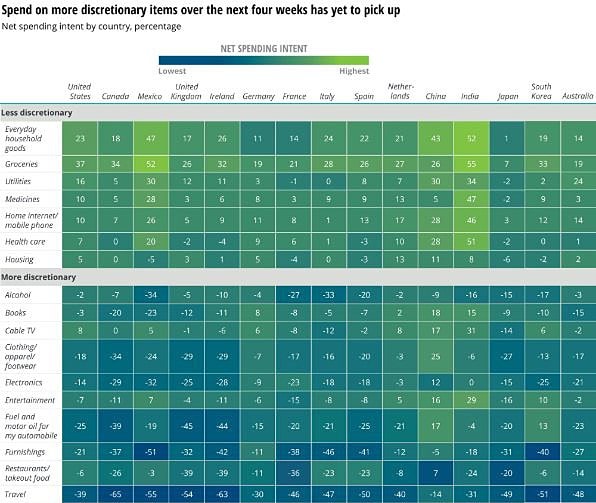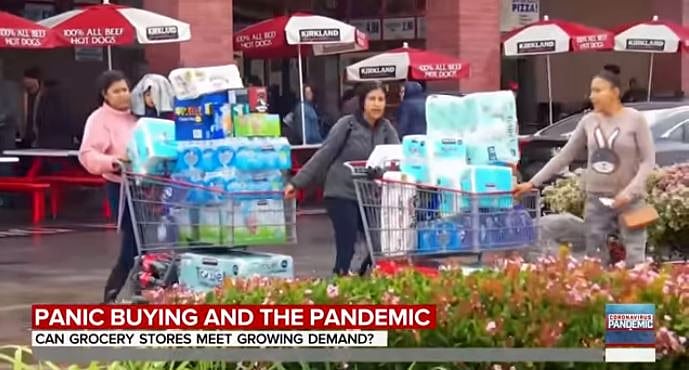Since the beginning of the pandemic, it was clear that it will change consumer behavior once and for all. The pandemic has also shown us how little we know about responsible consumption. It became clear when people started emptying the shelves in the supermarkets all over the world to stock up on goods. The Today Show reported that supermarket workers even had to work longer hours just to restock the goods and clean up properly.
Video credit: TODAY
But while some goods, like pantry groceries, bread, water, masks, and sanitizers, were essential, the necessity for other ‘in-demand’ products was very questionable.
The toilet paper frenzy is a good example of panic-buying and irresponsible consumption. The stocks of toilet paper in shops decreased so fast that some of them, like the U.S. supermarket chains Wegmans, Shoprite and Target, had to impose limitations on how much toilet paper one person could buy. Experts explain the obsessiveness around toilet paper with the so-called herd effect that, once again, shows that we would rather follow the purchase patterns of others than think about the true necessity of buying this product.
Are the Governments to Blame for Panic-Buying?
Governments around the world are partially responsible for creating this obsession with everyday goods. In the U.S., according to the report by CNBC, this reaction was triggered by the conflicting messages coming from the President and CDC. While the first party claimed that everything is under control, people still received worrying messages from CDC underlying the long-term dangers that this virus has brought along.
In other parts of the world, this situation got out of control as well.Governments of the Oceania countries, including Indonesia, Australia, and New Zealand, were preparing to intervene and limit the number of purchases per person because they were running out of essential goods.
In Hong Kong, while the government assured the citizens that all shops have enough supplies, big supermarkets quickly dismissed these claims saying they had to double deliveries of essential goods just to meet demands.
Such a reaction is rooted in our psychology. Apart from the above-mentioned herd effect, this situation can also be explained by fear contagion. Stress impairs our judgment. As a result, with unclear and confusing messages coming from the governments, we seek solutions in other people’s actions, provoking us to replicate these actions and take back control.
How Does Consumer Behavior Manifest Itself Now?
After the initial stage of panic-buying came the lockdown. The majority of consumers, mostly out of fear of getting the disease, were forced to restock their household essentials by shopping online.
E-commerce has proven to be an effective way to safely get the necessary supplies. After studying the growing impact of e-commerce during the COVID-19 pandemic in the U.S., India, South Korea, and Japan, McKinsey reports that consumers around the world intend to shop online more even after the pandemic is over.
Notably, the urge to panic-buy goods has switched to a more reasonable approach to spending money. You can see it in the graph from Deloitte’s report on consumer behavior.

Image credit: Deloitte
According to Deloitte’s report, two-thirds of all surveyed countries showed the intent to continue reducing expenses, spending money on the essential goods only. Apart from that, consumers seem to become less picky when it comes to brands. A consumer survey shows that 40% of people would turn to less familiar brands to purchase products from, while only 33% said they would wait until the store restocked their preferred brands.
This survey shows the growing change in brand preferences, indicating that consumers started focusing more on the availability of products and can now separate the value of the product itself from the brand that produces it.
What Does the Future Hold?
After living for more than four months in the world run by the pandemic, it is clear that consumers globally, by trial and error, have become more responsible. But people are unlikely to relapse to their pre-pandemic purchase behavior any time soon.
Although the world is slowly opening up again, the general net optimism of consumers around the globe still remains low. People expect a long-lasting impact from the pandemic, which means that changes in consumer behavior that we are already observing will remain strong.
What changes in consumer behavior can we expect in the future?
1) Rising Impact of Online Services
Today, we already see the growing demand for purchasing online services. Besides turning to e-commerce for buying groceries online, more and more people also turn to online platforms that help them run their business or continue doing their job remotely. This provokes an increase in demand for digitization.
Education is one of the areas that showed the need for digitization. While seemingly having more time, students still struggled to be present at all the classes and manage finishing homework and writing essays on time. Teachers, too, needed more digital solutions to manage online classrooms.
Global educational systems struggle because schools and universities were not prepared for remote learning and didn’t have enough tools to quickly switch to it. While, for students, a few tools like Grammarly, TrustMyPaper and SupremeDissertations are already available, helping them finish homework faster, there is still a growing need in teleconferencing and classroom management tools for teachers.
This increasing demand for digitization in education and other industries shows how consumer preferences expanded from shopping for goods online to purchasing online services, and this shift will likely become permanent in the upcoming future.
2) Decreasing Expenses on Healthcare
Unfortunately, not all changes are good. According to Healthcare Finance, 72% of U.S. consumers have switched to online checkups with their doctors, and most of them had to reduce their visits to hospitals because of financial hardships.
According to PWC, more than half of the U.S. consumers are planning to adjust and cut their expenses on healthcare visits and medication.

Image credit: PwC
Although people are getting more interested in virtual healthcare, because of the impact of the pandemic on the global economy, people are planning to spend less on health checkups. As a result, it might bring negative long-term effects on the health status of people around the world and increase the deteriorating effect of the COVID-19 virus on the global economy.
However, even though this trend in consumer behavior might affect us for some time, it will hopefully disappear once people regain financial stability.
3) Shift to Minimalism in Purchase Patterns
One of the current trends in consumer behavior, which is expected to last, is minimal consumption. We already mentioned that, after panic-buying goods at stores and going through financial hardships due to unemployment and other reasons, people became more conscious about consumption.
Sabrina Helm, a professor of Consumer Sciences from the University of Arizona, says there is a chance that the pandemic will change our consumerist society and make us more aware of the value of goods.
She reiterates that the longer people around the globe have to experience these hardships, the deeper the minimalistic attitude towards consumption will ingrain in our behavior. Of course, such behavior should also be supported by governments around the world, which have to continuously educate consumers on how to shop with more awareness.
The Change Is Inevitable
To sum up, the global pandemic has definitely changed the way we approach shopping and choose products. While the world had to go through trial and error with panic-buying, it made us more conscious about the value of products and to differentiate our wants from our needs.
Although the pandemic made us learn about responsible consumption the hard way and still remains our reality, for the time being, the changes to consumer behavior that it has already brought are mostly positive and will hopefully remain that way in the upcoming future.





0 Comments